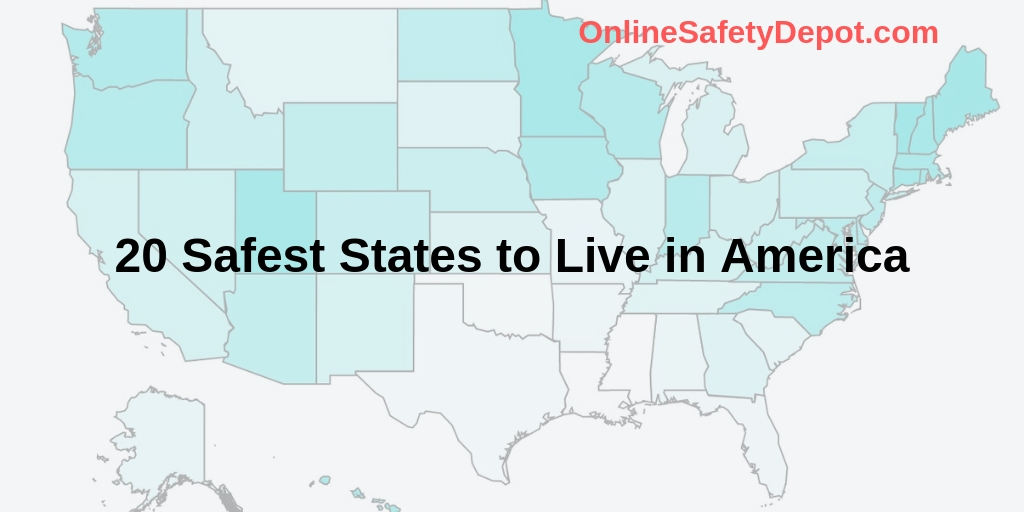20 Safest States to Live in America
As a parent, I am constantly thinking of the safety and well-being of my wife and three kids. If something were to ever happen to them, I fear my world would crumble around me. It seems to me that every time I read the news, there is a shooting or some sort of natural disaster that claims the lives of individuals – a father, mother, son, daughter, etc. Just a few months ago California experienced the most deadly and destructive wild fire in its history. The fire claimed the lives of 86 individuals and injured another 12.
In October of last year (2018) Hurricane ‘Michael’ struck the shores of Honduras, Nicaragua, El Salvador and the United States. With each country suffering a combined number of 60 deaths, United States recorded the highest death count among the countries at 45, according to THE ASSOCIATED PRESS. You can read more about that HERE
So, I decided to look for any data associated with where in the United States is the safest place to life. Obviously, there are several factors that could be included in such an analysis, and I am sure no one study could effectively determine and evaluate what all those factors are. However,
after doing some research, I found a study that was published by WalletHub in June of 2018 that evaluated several factors used to determine the safest places to live in America. The selected 5 factors I found interesting, and I was surprised by which states ranked well and ones that didn’t according to the factors evaluated. You can access that study by clicking HERE.
The top 20 safest states to live in America are:
| Overall Rank | State | Total Score | Personal & Residential Safety | Financial Safety | Road Safety | Workplace safety | Emergency Preparedness |
| 1 | Vermont | 66.02 | 2 | 3 | 9 | 17 | 9 |
| 2 | Maine | 65.41 | 4 | 8 | 14 | 11 | 3 |
| 3 | Minnesota | 61.86 | 11 | 7 | 1 | 2 | 22 |
| 4 | Utah | 61.39 | 21 | 10 | 6 | 4 | 2 |
| 5 | New Hampshire | 61.37 | 7 | 4 | 20 | 39 | 6 |
| 6 | Connecticut | 61.30 | 1 | 22 | 27 | 22 | 17 |
| 7 | Rhode Island | 61.12 | 5 | 21 | 3 | 24 | 11 |
| 8 | Hawaii | 59.42 | 12 | 6 | 39 | 19 | 5 |
| 9 | Massachusetts | 59.21 | 8 | 9 | 7 | 31 | 10 |
| 10 | Washington | 58.52 | 32 | 12 | 4 | 3 | 7 |
| 11 | Iowa | 56.97 | 3 | 11 | 18 | 13 | 43 |
| 12 | Wisconsin | 55.08 | 15 | 13 | 22 | 29 | 16 |
| 13 | Oregon | 54.39 | 39 | 16 | 10 | 14 | 14 |
| 14 | Indiana | 53.46 | 18 | 24 | 11 | 16 | 29 |
| 15 | Delaware | 53.18 | 16 | 39 | 21 | 33 | 15 |
| 16 | Maryland | 53.15 | 22 | 33 | 24 | 10 | 23 |
| 17 | North Carolina | 52.86 | 9 | 27 | 40 | 5 | 40 |
| 18 | New Jersey | 52.67 | 10 | 37 | 30 | 20 | 27 |
| 19 | Virginia | 52.54 | 27 | 15 | 26 | 6 | 30 |
| 20 | North Dakota | 52.54 | 6 | 2 | 8 | 49 | 41 |
NOTE: Data presented here is taken from the WalletHub study that can be found by clicking HERE:
The study focused on five (5) key indicators to determine the ranking factors for each state.
The Five Key Categories to Rank Each State:
1- Personal & Residential Safety
2- Financial Safety
3- Road Safety
4- Workplace Safety
5- Emergency Preparedness
In order to determine which states were the safest, WalletHub generated 48 different metrics, each housed in a different key factor category. Additionally, each metric was given an assigned weighted point system scored out of a 100.
The point ranking was either Half Weight = HW, Full Weight = FW, or Double Weight = DW.
Personal and Residential Safety:
Within this category, there were 18 of the 48 different factors or metrics that were considered when ranking each state. Total Points possible within this category is 40. They are:
- Terrorist Attacks: FW (~1.95 Points)
- Mass Shootings: FW (~1.95 Points)
- Manslaughters per Capita: DW (~3.90 Points)
- Forcible Rapes per Capita: DW (~3.90 Points)
- Assaults per Capita: DW (~3.90 Points)
- Thefts per Capita: FW (~1.95 Points)
- Sex Offenders per Capita: DW (~3.90 Points)
- Drug Abuses per Capita: FW (~1.95 Points)
- Law-Enforcement Employees per Capita: FW (~1.95 Points)
- Active Firefighters per Capita: FW (~1.95 Points)
- Emergency Medical Technicians and Paramedics per Capita: FW (~1.95 Points)
- Suicide Rate: FW (~1.95 Points)
- Bullying Incidence Rate: FW (~1.95 Points)
- Share of Elder-Abuse, Gross-Neglect and Exploitation Complaints: FW (~1.95 Points)
- Hate-Crime Incidents per Capita: FW (~1.95 Points)
- Hate Groups per Capita: FW (~1.95 Points)
- Number of Neighborhood Watch Groups: HW (~0.98 Points)
Financial Safety:
Within the Financial Safety category, there are 19 of the 48 different factors or metrics that were considered when ranking. Total Points possible within this category is 15. They are:
- Share of Uninsured Population: FW (~0.75 Points)
- Unemployment Rate: Double Weight (~1.50 Points)
- Underemployment Rate: FW (~0.75 Points)
- Foreclosure Rate: FW (~0.75 Points)
- Median Credit Score: FW (~0.75 Points)
- Debt per Income: FW (~0.75 Points)
- Poverty Rate: FW (~0.75 Points)
- Share of Adults with Rainy-Day Funds: FW (~0.75 Points)
- Fraud & Other Complaints per Capita: FW (~0.75 Points)
Note: “Other” includes both financial and nonfinancial complaints. - Identity-Theft Complaints per Capita: FW (~0.75 Points)
- Share of Unbanked Households: FW (~0.75 Points)
- Job Security: FW (~0.75 Points)
According to the WalletHub, this metric was calculated as follows: (Total Workers in 2017 – Total Workers in 2016) / Total Workers in 2016. - New Unemployment Claims per Total Civilian Labor Force: FW (~0.75 Points)
Note: “New Unemployment Claims” refers to the number of people making an initial claim for unemployment insurance benefits. - Employment Growth (2017 vs. 2016): FW (~0.75 Points)
Note: This metric was adjusted for the working-age population growth. - Share of Households with Emergency Fund: FW (~0.75 Points)
Based on the individuals/households who saved for unexpected expenses or emergencies in the past 12 months. - Share of People Not Saving Money for Children’s College: FW (~0.75 Points)
- Share of Households Behind on Bills in Past 12 Months: FW (~0.75 Points)
- Personal Bankruptcy Filings per Capita: FW (~0.75 Points)
- Share of Homes Underwater (with negative equity): FW (~0.75 Points)
Road Safety:
The Road Safety portion of the study focused on only 6 of the 48 metrics. Total Points possible within this category is 15. They are:
- Traffic Indiscipline (composite metric): FW (~1.88 Points)
This metric included incidents such as: phone use, speeding, aggressive acceleration, harsh braking, and poor turning. - Fatalities per 100 Million Vehicle Miles of Travel: DW (~3.75 Points)
- DUIs per Capita: FW (~1.88 Points)
- Pedestrian & Pedalcyclist Fatality Rate per Capita: DW (~3.75 Points)
- Road Quality: FW (~1.88 Points)
- Driving Laws Rating: FW (~1.88 Points)
Workplace Safety:
Surprisingly, the Workplace Safety portion of the study focused on only 4 of the 48 metrics. I would think that this portion of the study would include more. Total Points possible within this category is 15. They are:
- Fatal Occupational Injuries per 100,000 Full-Time Workers: Double Weight (~6.00 Points)
- Injuries & Illnesses per 10,000 Full-Time Workers: Full Weight (~3.00 Points)
- Median Days Lost Due to Occupational Injuries & Illnesses: Full Weight (~3.00 Points)
- Presence of Occupational Safety & Health Act Plans: Full Weight (~3.00 Points)
Emergency Preparedness:
While I was surprise by the few metrics used to determine the Workplace Safety category, I was even more surprised that there was only two (2) metrics used in the Emergency Preparedness category of the study. Total Points possible within this category is 15. They are:
- Number of Climate Disasters Causing $1 Billion+ in Damages in Past Decades:
FW (~7.50 Points)
Note: “Past Decades” refers to the period between 1980 and 2018. - Loss Amount from Climate Disasters Causing $1 Billion+ in Damages per Capita:
FW (~7.50 Points)
Note: This metric refers to the period between 1980 and 2018.
Conclusion
This study, its selected safety factor categories and metric configurations, and the resulting data provide some compelling reasons for determining the safest places in which to live. As would be expected, within each state different counties ranked safer to live in than others. Certainly, some may take exception to the factors used in analysis as well as the resultant state rankings. Nonetheless, the researchers obviously went to great lengths, based on known safety information, to compile the data and make the analysis. W

